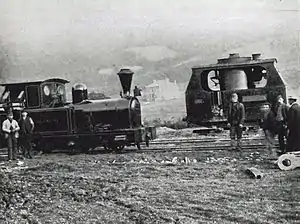Rheidol (locomotive)
Rheidol, formerly named Treze de Maio and Talybont, was a 2-4-0T steam locomotive built by W.G. Bagnall in Staffordshire, England, in 1896. Originally built to a gauge of 2 ft 5 1⁄2 in (750 mm), it was ordered to work at a Brazilian sugar plantation, however the order was cancelled before it was exported. The locomotive was then regauged and renamed to work on the 2 ft 3 in (686 mm)-gauge Plynlimon and Hafan Tramway, in Wales, where the locomotive worked from August 1897 until 1899. It was then regauged and renamed a second time, to work on the 1 ft 11 3⁄4 in (603 mm)-gauge Vale of Rheidol Railway,[1] which it did from 1900 until 1924, when it was scrapped.
| Treze de Maio; Talybont; Rheidol | |||||||||||||||||||||||||||||||||||||||||||||||||
|---|---|---|---|---|---|---|---|---|---|---|---|---|---|---|---|---|---|---|---|---|---|---|---|---|---|---|---|---|---|---|---|---|---|---|---|---|---|---|---|---|---|---|---|---|---|---|---|---|---|
 Talybont (left) with Victoria on the Plynlimon and Hafan Tramway | |||||||||||||||||||||||||||||||||||||||||||||||||
| |||||||||||||||||||||||||||||||||||||||||||||||||
| |||||||||||||||||||||||||||||||||||||||||||||||||
| |||||||||||||||||||||||||||||||||||||||||||||||||
| |||||||||||||||||||||||||||||||||||||||||||||||||
Construction
The locomotive was originally built by W.G. Bagnalls in 1896, following an order for a 2 ft 5 1⁄2 in (750 mm) gauge locomotive for a sugar plantation in Brazil. The locomotive was named Treze de Maio (Portuguese for "Thirteenth of May"), the date that Brazil had abolished slavery in 1888.[2] It was constructed as a 2-4-0T locomotive with outside frames, and fitted with a spark arresting chimney. It was completed and named by February 1897, but the order was cancelled before the loco was exported. This may have been due to a political uprising in Brazil, though this is disputed by railway historian EA Wade.[2]
Plynlimon and Hafan Tramway
The Plynlimon and Hafan Tramway was a short-lived 2 ft 3 in (686 mm) railway built in 1897, operating from Llanfihangel via Talybont to serve lead mines in Mid-Wales. The railway's first locomotive, Victoria, was of an unusual design, and not sufficiently powerful to operate on the railway, and therefore the owners of the line approached Bagnalls to provide a new locomotive urgently (Bagnalls also supplied their works number 1510, Hafan, to work the upper section of the tramway). As Treze de Maio was available it was regauged and renamed Talybont, and delivered to the Plynlimon and Hafan Tramway in August 1897, still with its spark arresting chimney.[2][3]
The Plynlimon and Hafan Tramway was not an economic success, and closed in 1899, just two years after opening. Talybont was then sold back to Bagnalls.[4]
Vale of Rheidol Railway
The Vale of Rheidol Railway is a 1 ft 11 3⁄4 in (603 mm) railway that operates between Aberystwyth and Devil's Bridge, a few miles south of the route used by the Plynlimon and Hafan Tramway. Construction of the line started in 1900, and Talybont was sold to the contractors working on the line, Pethick Bros of Plymouth. The locomotive underwent a second change of gauge, and modification work was also carried out to its cylinders. After completion of the line in 1902, the locomotive was returned to Bagnalls for further modifications, before it was named Rheidol and became the railway's No. 3.[4] It was the line's only loco small enough to work the railway's Harbour Branch.[5]
In 1904, the locomotive was fitted with a conventional chimney, and at some point was fitted with a steel cab back.[4] The Vale of Rheidol Railway was taken over by the Great Western Railway (GWR) in 1923 and the locomotive was allocated the number 1198.[6] Rheidol was withdrawn in 1923 and scrapped at Swindon Works in 1924, having never carried its GWR number.[4]
References
- Green 1986, p. 189.
- Wade 1997, p. 37.
- Green 1986, p. 204.
- Wade 1997, p. 39.
- Green 1986, p. 107.
- Green 1986, p. 205.